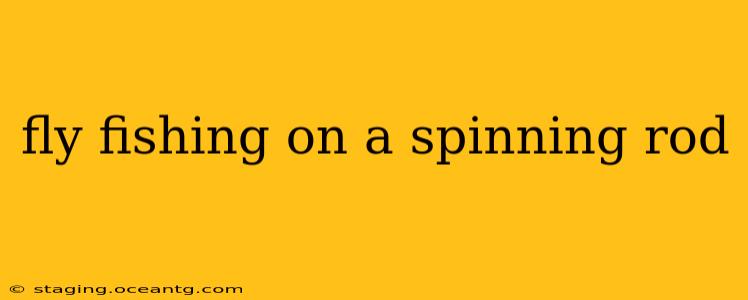Fly fishing, traditionally associated with delicate fly rods, can surprisingly be adapted to spinning gear. While not a direct replacement for the fly rod experience, using a spinning rod for fly fishing opens up unique possibilities and offers advantages in specific situations. This guide delves into the technique, addressing common questions and exploring its potential.
Why Use a Spinning Rod for Fly Fishing?
The primary advantage of using a spinning rod for fly fishing lies in its versatility. Spinning rods are generally more robust and durable than fly rods, making them ideal for tackling challenging environments with heavy cover or strong currents. They also offer a significant advantage in casting heavier flies or larger streamers which can be difficult to cast effectively with a fly rod. This opens up a wider range of fishing opportunities, particularly for larger predatory fish.
What Kind of Spinning Rod and Reel Should I Use?
The best spinning rod for fly fishing will depend on your target species and fishing conditions. Generally, a medium-light to medium power rod with a fast action is a good starting point. The length should be chosen based on the environment – shorter rods (6-7 feet) are ideal for tight spaces, while longer rods (7-8 feet) provide greater casting distance.
The reel should be a smooth-spinning model capable of holding a sufficient amount of line. While you don't need a super high-end reel, a reliable model with a good drag system is crucial to managing larger fish.
What Kind of Line Should I Use?
This is where things differ significantly from traditional fly fishing. You won't be using fly line. Instead, you'll use a weight-forward spinning line appropriate for your rod and conditions. The weight of the line will help to cast the fly effectively, particularly important when using heavier flies or in windy conditions. Consider using a braided line as the main line, followed by a fluorocarbon leader. This combination offers both strength and sensitivity.
What Flies Work Best with a Spinning Rod?
While delicate dry flies are not suitable for this technique, larger streamers, weighted nymphs, and even some poppers can be effectively fished with a spinning rod. The weight of the fly helps with casting and penetration in the water. Select flies based on the target species and water conditions.
Can I Use a Fly Reel With a Spinning Rod?
No, this combination isn't practical. Fly reels are designed to work with fly line and aren't compatible with spinning lines and lures. Using a fly reel with spinning tackle will likely lead to problems with line management and casting.
What are the Disadvantages of Fly Fishing with a Spinning Rod?
The most significant drawback is the loss of the delicate presentation often associated with fly fishing. While you can still catch fish, the subtle presentation achievable with a fly rod is difficult to replicate with a spinning rod. This makes this technique more effective for larger, less discerning fish, or in situations where a more powerful casting style is needed.
Is this Technique Right for Me?
If you're looking for a more versatile approach to fishing, particularly in situations where your fly rod might struggle, then using a spinning rod can be a very effective method. It's particularly suitable for targeting larger fish with heavier flies in challenging environments. However, if your goal is the finesse and delicacy of traditional fly fishing, then a fly rod will remain the better option.
Conclusion
Using a spinning rod for fly fishing isn't a replacement for traditional fly fishing techniques, but it is a valuable and effective alternative in specific circumstances. The added power, versatility and durability offer unique advantages, opening doors to new fishing scenarios. Experimentation and understanding your environment are key to mastering this unique approach.
